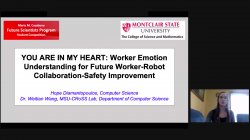Computer Science Major Wins Casabona Presentation Competition
Hope Diamantopoulos, mentored by Dr. Weitian Wang, was voted best presentation by the panel of professional judges
Posted in: Awards and Recognition, Department Research, Students

Hope’s talk was titled, YOU ARE IN MY HEART: Worker Emotion Understanding for Future Worker-Robot Collaboration-Safety Improvement, and delved into the teaching of emotions to improve worker-robot collaborations as we move toward more automated production. The strength of the algorithms effectiveness and its applicability really impressed the judges. First place came with a prize of $2000 for Hope, and $1500 for Dr. Wang. Read the full recap of the event on the CSAM website.
Abstract
Smart manufacturing, which has attracted an increasing number of investors in recent years, plays a key role in the fourth industrial revolution, with prominent characteristics such as mass customization and high flexibility. Human worker-robot collaboration is inevitable in smart manufacturing as industries push towards a more efficient and innovative future. Enabling collaboration between workers and robots allows robots to handle the repetitive and mind-numbing tasks that might lead to human boredom or, worse, error. It is imperative that robots are able to thoroughly understand worker-robot collaboration dynamics, especially workers’ subjective feelings, and adjust actions accordingly. This allows human workers to provide input on and control the more difficult endeavors and ensures a safe future in which workers feel comfortable. However, few studies have been conducted on the issues of human subjective factors in worker-robot collaboration. In an effort to ensure safe worker-robot collaboration in smart manufacturing tasks, we teach a collaborative robot to understand 7 different human emotions. In this presentation, our development process, the robot learning algorithm, and real-world experimental results will be shown and discussed. This project works on real-time on-site human emotion understanding, so it would prove quite useful in manufacturing environments where collaborative robots are already being utilized (and will continue to be utilized more and more with time). Our approach can enable the robot to accurately understand different worker emotions. By way of example, if the worker seems upset or hesitant, the robot will slow down, and if the worker seems to be upbeat or in a good mood, the robot will pick up the pace, matching the human worker’s energy. This allows for safe collaboration in worker-robot partnerships, fostering efficient working environments, improving ergonomics, and empowering future workforce. A future roadmap of this work and its potential commercial value will also be discussed.
